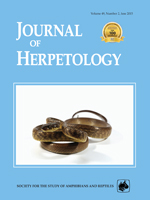Two cranial osteoderms and a maxilla assigned to Heloderma suspectum (Squamata, Helodermatidae) were recovered from the 111 Ranch fossil locality, San Simon Valley, Graham County, southeastern Arizona. A minimum age of the deposits and fossils is approximately 2.7–2.4 million years ago, latest Blancan Land Mammal Age, spanning the Pliocene-Pleistocene boundary. The presence of a pronounced deep venom grove and a tooth count of eight indicate that the maxilla belongs to Heloderma and not the closely related and extinct Lowesaurus or Eurheloderma. The highly reduced nasolacrimal fossa and the shortened projection of the maxillary lappet on the fossil agree with the condition in H. suspectum and not in Heloderma horridum. During this transition time, the locality was a mosaic grassland–woodland ecosystem with open water and riparian niches occupied with grazing and browsing mammals.
How to translate text using browser tools
1 June 2015
Early Pleistocene (Blancan) Helodermatid Lizard from Arizona, USA
Jim I. Mead,
Sharon Holte,
Richard S. White,
Robert McCord
ACCESS THE FULL ARTICLE

Journal of Herpetology
Vol. 49 • No. 2
June 2015
Vol. 49 • No. 2
June 2015




